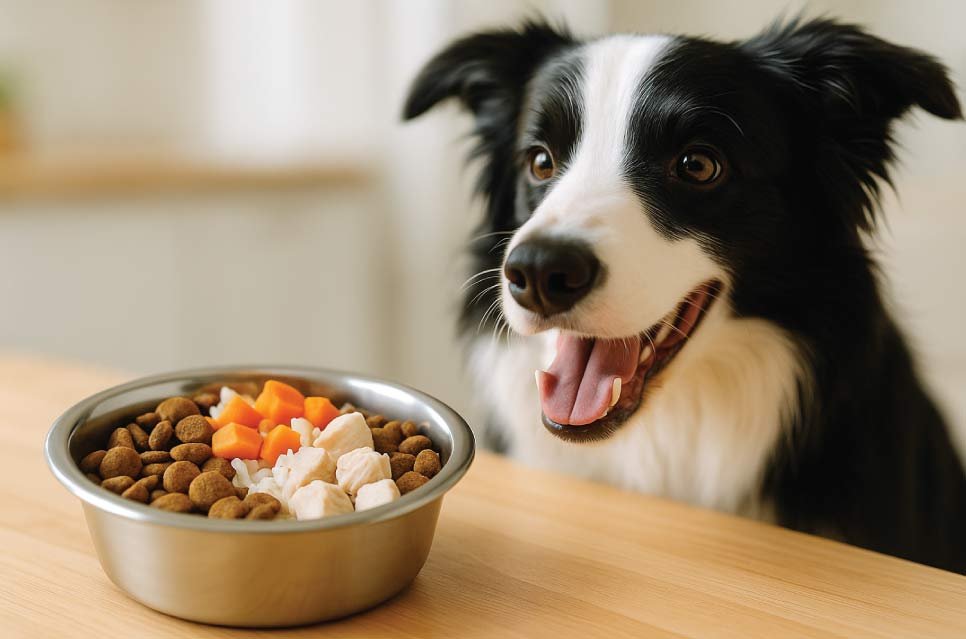At PetSweetJoy, we sometimes share products we truly love and use with our own pets. This post contains affiliate links, which means we may earn a small commission, at no extra cost to you. We only recommend products that fit our values of care, comfort, and responsible pet parenting.💗
Do you know how nutrition shapes a lifetime of joy for your dog? Every wag, every sparkle in your dog’s eyes, every happy sigh as they curl up beside you, it all begins with what’s in their bowl. Nutrition is more than just feeding; it’s how we nurture health, trust, and love throughout our dogs’ lives. From playful puppy zoomies to peaceful senior naps, food fuels every moment of joy we share.
At PetSweetJoy, we believe that good pet care starts with understanding, not perfection. Every dog is unique, and the best diet is one that fits their body, their rhythm, and your lifestyle. Our approach is simple: care with love, learn with patience, and feed with confidence.
If you’re just starting your journey as a dog parent, you might find our Dog Care Tips for Beginners helpful, it’s a gentle starting point to build daily routines that make your dog feel safe, happy, and understood.
Whether your companion is a bouncing puppy discovering the world or a wise senior resting by your side, one truth remains: balanced nutrition is the foundation of a long, joyful life.

Let’s explore how to feed with confidence, from understanding what “complete and balanced” really means, to choosing foods that fit your dog’s age, energy, and unique personality.
💗 “Good nutrition isn’t just about food, it’s how we say ‘I love you’ every single day.”
Listen to the Podcast: Dog Nutrition Guide
Understanding the Core of Dog Nutrition
1. Balanced Nutrition 101
Just like us, our dogs thrive when they eat a variety of nutrients that support every cell, bone, and heartbeat. A balanced diet is the quiet hero behind your dog’s energy, shiny coat, and lifelong vitality.
In essence, your dog’s body needs six essential nutrients: water, protein, fat, carbohydrates, vitamins, and minerals. Each one has a special job, from keeping joints moving to protecting the heart and immune system. When these nutrients come together in the right amounts, they form the building blocks of health.
Think of your dog’s diet as a team effort:
- Proteins repair tissues and build muscle.
- Fats provide energy and keep the coat glossy.
- Carbohydrates offer fuel for play and focus.
- Vitamins and minerals handle the behind-the-scenes magic, keeping everything running smoothly.
- And water, the unsung hero, keeps every system hydrated and balanced.

The simplest way to make sure your dog gets all this goodness? Choose foods labeled “complete and balanced,” which means they meet the nutritional standards established by the AAFCO (Association of American Feed Control Officials). These foods have been tested to ensure your dog receives all essential nutrients in proper proportions for their life stage, whether puppy, adult, or senior.
For a full breakdown of each nutrient and how it supports your dog’s body, you can read our in-depth guide: Dog Nutrition: What Is the Ideal Nutrition for a Dog?
Takeaway: Always look for AAFCO’s “complete and balanced” statement on your dog’s food label, it’s your first sign of quality and safety.
2. Dogs Are Omnivores (Not Strict Carnivores)
You’ve probably heard that dogs are descendants of wolves, but here’s an important truth: today’s dogs are omnivores, not strict carnivores. That means they can safely digest and absorb nutrients from both plant and animal sources.
While meat offers essential amino acids, a touch of healthy grains, fruits, and vegetables can enrich your dog’s diet with fiber, antioxidants, and natural vitamins. Many high-quality foods blend these ingredients for a balanced, digestible meal.
In our home, even Lazy, my 14½-year-old Galgo, loves his occasional carrot slice. It’s his favorite crunchy treat and a good reminder that dogs don’t need a purely meat-based diet to thrive. What matters most is balance, not strict rules.
Takeaway: Dogs can enjoy both plant- and animal-based foods, the key is choosing safe, balanced nutrition that supports their individual needs.
3. Raw vs. Home-Cooked Diets, What’s Right for Your Pup?
If you’ve ever wondered whether a fresh, home-cooked, or raw diet might be better for your dog, you’re not alone. Many loving pet parents feel the same tug, wanting to give their dogs the purest, most wholesome food possible. The good news? You have options! The key is understanding how to keep those options both safe and nutritionally complete.
A. The Appeal of Fresh Feeding
Fresh diets feel natural, they smell good, look real, and often make us feel more connected to how we care for our dogs. But what matters most isn’t just the look of the food, it’s the balance of nutrients and the safety of preparation.
Both raw and home-cooked diets can work beautifully when formulated correctly, but when they aren’t, dogs can easily miss out on crucial nutrients like calcium, zinc, or B12. That’s why professional guidance from a veterinarian or a board-certified veterinary nutritionist is essential if you’re crafting meals at home.

B. Home-Cooked Diets
Pros:
- You control every ingredient, ideal for sensitive tummies or allergies.
- Can be a heartfelt way to show care and bond with your dog.
- Works well for short-term use during recovery or illness (with vet advice).
Cons:
- It’s extremely difficult to balance nutrients without expert help.
- Common deficiencies include calcium, iron, and zinc.
- Takes time and consistency to plan, cook, and portion meals safely.
🐾 If you love the idea of home cooking, consider working with your vet to design recipes that ensure all vitamins and minerals are covered, love is powerful, but science keeps it safe!
C. Raw Diets
Raw feeding appeals to those who want to mimic a more “natural” canine diet, high in fresh meat and minimal processing. Raw diets can be beneficial when they meet AAFCO standards and are made from clean, safe sources.
However, raw diets that are not properly balanced or handled can carry health risks, such as bacteria (like Salmonella or Listeria) or nutrient imbalances. The safest path? Choose veterinarian-approved, AAFCO-complete commercial raw foods. Find a board-certified veterinary nutritionist near you.
Here are a few trusted options to explore:
🐾 Premium Raw Food Options
- RAW WILD 12 lbs Premium Raw Dog Food – Ideal for Small Dogs Made from 100% wild-grown elk and deer meat from the Rocky Mountains. No hormones, antibiotics, grains, or fillers, just pure, natural goodness. AAFCO complete and balanced.
- RAW WILD 24 lbs Premium Raw Dog Food – Ideal for Medium Dogs The same pristine quality for medium-sized dogs needing natural energy and top-tier nutrition.
🐾 Vet-Formulated Precision Nutrition
- Royal Canin offers puppy formulas, adult recipes, and senior blends, each scientifically tailored to life stage, size, and breed. Developed through veterinary research, these diets ensure precise, balanced nutrition for every dog.
🐾 Natural, Sustainable Nutrition
- ZEAL Dog Food, Rooted in New Zealand, ZEAL offers wholesome, sustainable wet and dry food crafted from grass-fed pastures and responsibly sourced ingredients. No fillers, no compromises, just real, nutritious food.
D. Quick Transition Tips, Switching Diets Safely
Dogs’ digestive systems need time to adjust when changing food types. A slow transition prevents stomach upsets and helps your pup adapt happily.
Here’s a gentle 8–10 day transition plan:
- Days 1–3: Mix 25% new food with 75% old food.
- Days 4–5: Increase to a 50/50 blend.
- Days 6–7: Move to 75% new food, 25% old.
- Days 8–10: Feed 100% new food.
- Watch & Adjust: If your dog’s stool softens or appetite changes, stay at the previous ratio for a few days before moving forward.
💡 Bonus tip: Keep a food diary noting energy, stool consistency, and any changes in coat or mood. It’s an easy way to track what works best for your dog.
E. Gentle Vet Reminder
💗 Before switching to raw or home-cooked diets, always talk with your vet. They can help ensure your dog’s diet stays safe, complete, and joyful, because every healthy meal is an act of love.
Takeaway: The “best” diet is one that keeps your dog safe, balanced, and thriving, whether it’s commercial, raw, or home-cooked with expert support.
Feeding by Life Stage, Tailoring the Bowl Over Time
Just like us, dogs’ nutritional needs change as they grow, mature, and slow down. What fuels a playful puppy isn’t the same formula that comforts a wise senior with a graying muzzle. The secret to lifelong health is adjusting their diet to match their life stage, not sticking to a one-size-fits-all meal.

1. Puppies, Growing Strong and Happy
Puppies are little bundles of joy (and mischief) that burn through energy faster than we can say “sit.” They need food that supports rapid growth, brain development, and strong bones.
- High Energy Needs: Puppies can require up to twice the calories of an adult dog their size.
- Meal Frequency: Start with 4 meals daily until 12 weeks old, then 3 meals until 6 months, and finally 2 meals a day as they reach adolescence.
- Nutrient Focus: Choose a formula rich in protein, calcium, and DHA for brain and eye development.
- Large Breed Note: If your pup will grow over 70 lbs, select a large-breed puppy formula to avoid bone and joint issues from too-rapid growth.
🐶 Puppyhood is all about steady progress, not speed. Balanced nutrition now prevents health issues later.To give your little one the right start, explore Royal Canin’s Puppy Nutrition Range expertly formulated to support healthy growth and strong development.
2. Adult Dogs, Balance and Consistency
By 12–18 months (a bit later for giant breeds), your dog’s growth plateaus and it’s time to shift focus to maintenance, portion control, and energy balance.
- Meal Routine: Two consistent meals a day, spaced about 8–12 hours apart, help stabilize energy and digestion.
- Activity Adjustment: Dogs that love long walks or play fetch daily need slightly more calories, while couch cuddlers need less.
- Weight Awareness: You should easily feel your dog’s ribs but not see them; a visible waist is a good sign.
If your dog loves training sessions or daily adventures, balance food and playtime, movement is just as nourishing as what’s in the bowl. For a diet that keeps up with their energy and lifestyle, try Royal Canin’s Adult Dog Food Range, crafted to maintain strength, vitality, and digestive balance.
For ideas to keep your adult dog happily active, check out A Tired Dog is a Happy Dog? Finding the Balance.
🦴 Consistency keeps adult dogs content, predictable meals, measured portions, and mindful movement.
3. Senior Dogs, Nurturing the Golden Years
As dogs reach their senior stage, around 7 years old for small breeds and as early as 5 for larger breeds, their metabolism slows down. They may gain weight more easily and need extra support for joints, digestion, and immunity.
Key goals for senior feeding:
- Fewer Calories: Most older dogs need about 20% fewer calories than middle-aged adults.
- High-Quality Protein: Keep protein levels high to preserve muscle mass and strength.
- Joint Support: Look for diets containing Omega-3 fatty acids (for inflammation) and antioxidants like Vitamin E and Beta-carotene (for immune health).
- Digestibility: Softer, easily digestible food makes mealtimes comfortable, especially for dogs with dental sensitivity.
In my home, my senior Galgo Lazy, now 14½, taught me the beauty of slowing down. She still loves her walks but takes them at her own rhythm. Her meals are smaller, softer, and enriched with healthy oils for joint comfort. Every bite feels like a quiet thank-you for the years we’ve shared.
Support your loyal companion through their golden years with Royal Canin’s Senior Dog Food Range, designed to nurture healthy aging, joint mobility, and vitality in older dogs.
💗 Feeding a senior dog isn’t just about nutrients, it’s about honoring their lifetime of loyalty with patience and love.
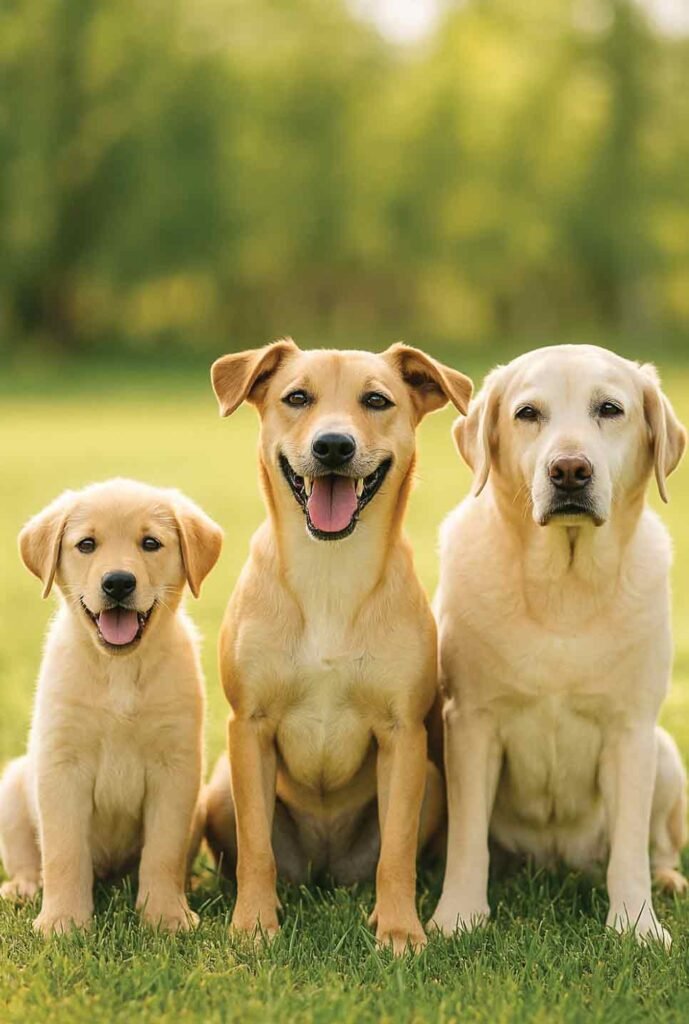
Life-Stage Feeding Summary Table
| Life Stage | Meals per Day | Key Nutrient Focus | Feeding Tip |
|---|---|---|---|
| Puppy | 3–4 | Protein, Calcium, DHA | Choose puppy-specific or large-breed puppy formulas for balanced growth. |
| Adult | 2 | Protein/Fat balance | Adjust portions to activity level; maintain visible waist and rib feel. |
| Senior | 2 (smaller portions) | Softer food supports digestion and dental comfort. | High-quality protein, Omega-3s, Antioxidants |
Takeaway: Your dog’s diet should evolve as they do. Feeding by life stage means giving them what they need most, energy in youth, balance in adulthood, and gentle care in their golden years.
Portion Control, Treat Limits & Healthy Weight
Feeding your dog isn’t just about choosing the right food, it’s also about giving the right amount. Even the healthiest diet can cause problems when portions are too big (or too small). Finding that sweet spot between love and overfeeding is one of the most caring things you can do for your furry friend.
1. Why Portion Control Matters
Overfeeding is one of the most common mistakes well-meaning dog parents make. It’s so easy to give in to those adorable eyes, but too many calories add up fast. About one in four dogs in Western countries is overweight or obese, and extra pounds can lead to joint pain, diabetes, heart disease, and a shorter lifespan.
How to tell if your dog’s weight is healthy:
- You should feel your dog’s ribs easily under a thin layer of fat.
- From above, there should be a slight waist behind the ribs.
- From the side, you should notice a gentle tummy tuck instead of a sag.
If your pup seems a little too round, don’t worry, small changes in feeding and exercise can make a big difference over time.
🐾 A measuring cup and a loving heart are your best tools for a healthy dog.
2. Treat Math, The 10% Rule
Treats are wonderful for training, bonding, and pure joy, but they should make up no more than 10% of your dog’s daily calories. That way, your dog enjoys rewards without accidentally taking in too much energy.

Here’s a quick guide to help you estimate how many treat calories fit within that 10% rule:
| Dog’s Weight | Estimated Daily Calories (Maintenance) | Treat Limit (10%) |
|---|---|---|
| 5 kg / 11 lbs | 400 kcal | 40 kcal |
| 10 kg / 22 lbs | 650 kcal | 65 kcal |
| 20 kg / 44 lbs | 1,050 kcal | 105 kcal |
| 30 kg / 66 lbs | 1,450 kcal | 145 kcal |
| 40 kg / 88 lbs | 1,800 kcal | 180 kcal |
To put this in perspective, a single large biscuit can contain up to 100 calories!
Healthy treat swaps your dog will love:
🥕 Carrot sticks (crunchy and low-calorie)
🍓 Sliced strawberries
🥦 Steamed broccoli or snap peas
🍗 Tiny bits of boiled chicken (protein boost)
💗 Treats are for joy, not for meals. Keep them small, safe, and balanced with daily exercise.
3. The Food–Movement Connection
Just like in humans, balance is everything. A dog that gets regular exercise can enjoy their food more freely, while a sedentary dog may need smaller portions to stay fit.
Playing fetch, going for mindful walks, or trying puzzle feeders can all help keep your pup active and mentally stimulated. You can find more playful ideas in our post A Tired Dog is a Happy Dog? Finding the Balance, where we explore how movement and relaxation work together for total wellbeing.
🦴 Healthy weight isn’t about restriction, it’s about joyful balance between food, play, and rest.
4. Practical Tips for Everyday Feeding
- Use a kitchen scale or measuring cup to portion meals precisely.
- Split daily food into smaller portions for training or enrichment toys.
- Avoid feeding table scraps (a piece of toast for a dog = a burger for us!).
- Weigh your dog every few weeks to track progress, consistency beats guesswork.
- Adjust portions with the seasons; dogs often need fewer calories in cold months if they move less.
Takeaway: Feed with love, but measure with care. Portion control, mindful treats, and regular play are the foundation of your dog’s lifelong health.
Safe Feeding Practices & Foods to Avoid
Dogs have a way of turning every mealtime into a moment of excitement, tails wagging, eyes sparkling, and noses twitching. But sometimes, that enthusiasm can lead to curious snacking on things that aren’t safe. Knowing what’s dangerous (and how to prevent accidents) is one of the simplest ways to protect your dog’s health. ASPCA’s list of toxic foods and plants for dogs.
1. The “No-Go” List, Foods That Are Toxic for Dogs
Even a small amount of certain human foods can cause serious problems for dogs. Here’s a quick reference guide to keep handy:
| Food | Why It’s Dangerous |
|---|---|
| Chocolate | Contains theobromine and caffeine, which can cause vomiting, tremors, and heart issues. |
| Grapes, Raisins, Currants, Sultanas | Can trigger sudden kidney failure, even in small amounts. |
| Onions, Garlic, Leeks, Chives, Shallots | Damage red blood cells and may cause life-threatening anemia. |
| Xylitol (artificial sweetener) | Found in gum, peanut butter, and sugar-free treats; can cause severe hypoglycemia and liver failure. |
| Alcohol & Caffeine | Affect the central nervous system and heart rhythm, never safe in any dose. |
| Macadamia Nuts | Lead to weakness, tremors, and vomiting. |
| Moldy or Spoiled Food Waste | Can contain dangerous mycotoxins, leading to tremors, seizures, or liver damage. |
| Cooked Bones | Can splinter easily, causing choking or internal injuries. |
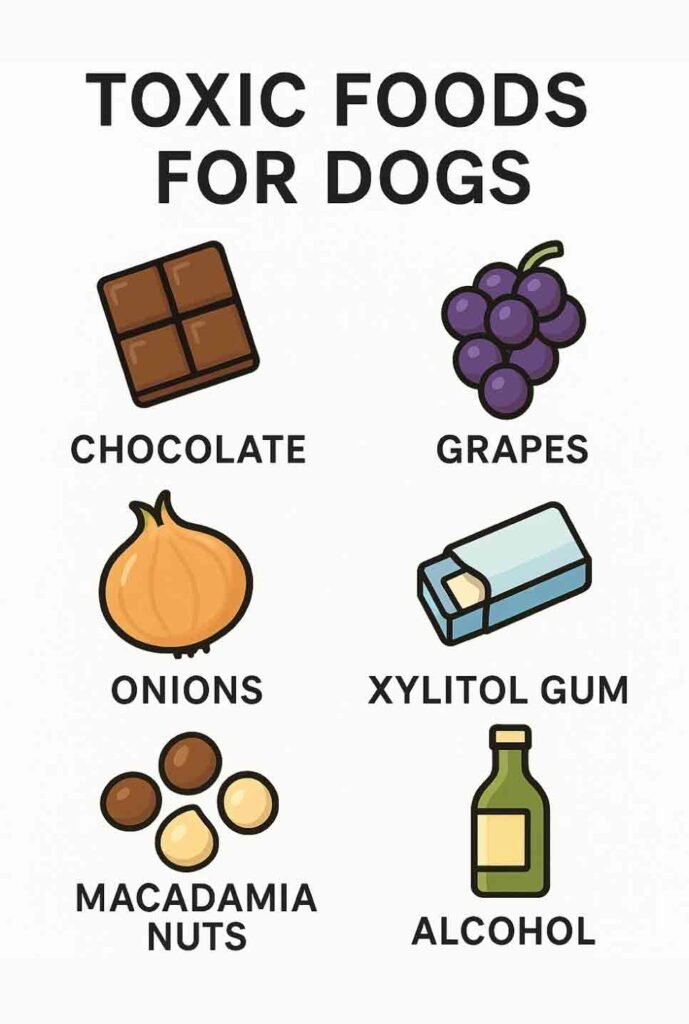
🐶 If you suspect your dog has eaten something toxic, contact your vet or a pet poison hotline immediately. Quick action can save lives.
2. Everyday Feeding Safety Tips
A few simple habits can prevent common food-related issues:
- Stick to a routine: Feed your dog at the same times daily to regulate digestion.
- Store food properly: Keep kibble sealed and raw or cooked food refrigerated.
- Watch for spoilage: Don’t feed leftovers past their safe window.
- Check the bowl: Use stainless steel or ceramic bowls, they’re cleaner and more hygienic than plastic.
- Skip the table scraps: Human meals are often too salty, fatty, or spicy for dogs.
💡 A good rule of thumb: If it’s seasoned for humans, it’s probably not safe for dogs.
3. Switching Foods the Right Way
Changing diets too quickly, whether from kibble to wet, or between brands, can cause temporary digestive upset. The solution? Go slow.
Here’s a gentle transition plan:
- Days 1–3: 25% new food + 75% current food
- Days 4–5: 50/50 mix
- Days 6–7: 75% new food + 25% current food
- Day 8+: 100% new food
Watch your dog’s stool and energy levels, if things look off, stay at the previous ratio for a few days before continuing.
For curious dogs who occasionally nibble on grass, it’s often harmless, but persistent vomiting or lethargy can signal something deeper. You can learn more about that behavior in our guide Why Do Dogs Eat Grass and Then Throw Up?.
4. Pancreatitis & Other Avoidable Problems
Feeding overly fatty meals or sneaking table scraps can cause pancreatitis, a painful inflammation of the pancreas that leads to vomiting, loss of appetite, and abdominal pain.
Also watch for:
- Sudden diarrhea after a diet change
- Repeated gas or bloating
- Food sensitivities that show up as itchy skin or ear infections
If any of these sound familiar, it’s worth talking with your vet about whether your dog’s diet might be the culprit.
💗 Love means learning what helps your dog thrive, and sometimes that means saying “no” to the things they think smell amazing.
Bold takeaway: The safest food is one chosen with love, stored with care, and served with awareness. Avoid risky ingredients, feed mindfully, and your dog will stay happy, healthy, and tail-wagging for years to come.
When Nutrition Becomes Medicine
Sometimes, nutrition isn’t just about staying healthy, it becomes part of the healing process. Just like certain foods can prevent problems, the right diet can help manage existing conditions and improve your dog’s comfort, mobility, and quality of life.
This is where therapeutic diets come in. These aren’t “trendy” foods or flavor variations, they’re scientifically formulated to support dogs with specific health challenges and are usually available through veterinarians.
1. The Role of Veterinary Professionals
When your dog faces a health issue, whether it’s allergies, kidney disease, or sensitive digestion, your veterinarian becomes your most valuable ally. They can help interpret confusing labels, calculate calories for weight control, or recommend specialized diets designed for medical support.
Veterinary teams often use your dog’s age, breed, activity, and lab results to recommend food that supports their organs and immune system without overburdening them. American Veterinary Medical Association’s dog nutrition tips
💗 Every dog is unique, and your vet’s guidance helps transform feeding into personalized care.
2. Common Conditions That Benefit from Specialized Diets
| Condition | How Nutrition Helps |
|---|---|
| Kidney Disease | Lower-protein, lower-phosphorus diets reduce the workload on kidneys. |
| Liver Problems | Controlled-protein and antioxidant-rich foods support detoxification and reduce ammonia build-up. |
| Obesity | High-fiber, lower-calorie diets aid weight loss while maintaining satiety. |
| Joint Issues / Arthritis | Diets enriched with Omega-3 fatty acids and glucosamine support joint mobility. |
| Allergies or Skin Sensitivities | Limited-ingredient or hydrolyzed-protein diets reduce allergic reactions. |
| Digestive Disorders (IBS, IBD) | Easily digestible foods with prebiotics promote gut balance. |
These foods are typically formulated under veterinary supervision, using precise nutrient ratios that target each condition without causing side effects.
🦴 Therapeutic diets don’t replace love and play, they simply make sure your dog can enjoy them longer.
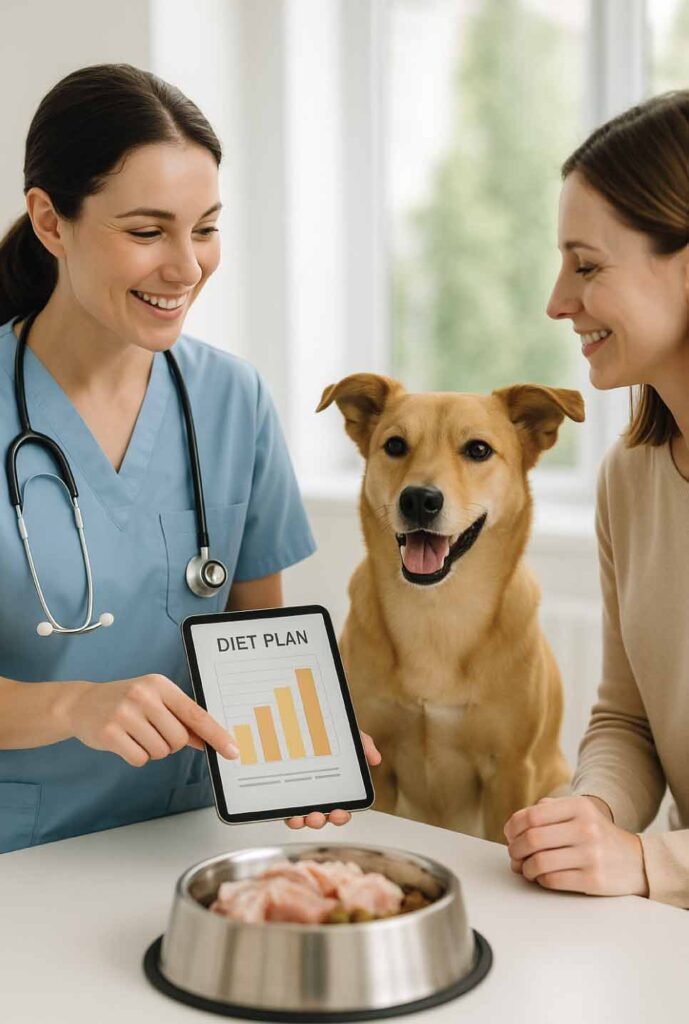
3. Supplements: Handle with Care
It’s tempting to add extra vitamins, oils, or herbs, especially when you want to “boost” your dog’s health. But more isn’t always better.
Adding supplements to a complete and balanced commercial diet can easily lead to nutrient excesses or interfere with medications.
Always talk to your vet before introducing anything new, even natural products, to make sure they’re safe and appropriate for your dog’s age and condition.
4. When to Seek Nutritional Advice
Call your vet if your dog shows:
- Persistent itching, dull coat, or ear infections
- Unexplained weight changes
- Vomiting or loose stool that lasts more than two days
- Fatigue or loss of appetite
- Increased thirst or urination
These may be early signs that your dog’s current diet isn’t meeting their needs, or that a health issue is developing.
🌿 Don’t wait for a big problem to appear. Adjusting nutrition early can prevent long-term complications and bring your dog lasting comfort.
Takeaway: Food can heal, support, and comfort, but only when guided by science and love. Partnering with your vet ensures every bite your dog takes moves them closer to a healthier, happier life.
Lazy’s Lesson, The Beauty of Adaptation
Every pet parent has that one companion who teaches them something profound. For me, that teacher is Lazy, my 14½-year-old Spanish Galgo. We’ve shared a lifetime of quiet mornings, zoomie-filled afternoons, and long naps under the same blanket. Through the years, Lazy has shown me what true adaptation looks like, not just in life, but in nutrition, too.
When she was young, Lazy was pure energy, graceful, curious, and impossible to tire out. Her meals were full of rich protein and balanced calories to match his active nature. I learned quickly that food was more than fuel; it was part of how she felt loved and secure.
As time passed and her stride slowed, so did her needs. Her once hearty meals became lighter and softer, with gentle portions to keep his joints and digestion happy. Adding a little fish oil helped his coat shine, and smaller, frequent meals made her more comfortable.
It hasn’t always been a perfect science, some days she’s picky, others she eats with joy, but that’s the beauty of long-term care. Nutrition isn’t a fixed formula; it’s an ongoing act of love and observation.
Lazy’s journey reminds me daily that caring for a senior dog means listening, adjusting, and respecting their rhythm. Some days, that means an extra spoonful of her favorite food. Other days, it means a quiet moment together, letting her nap before dinner.
💗 The best diet is one that evolves, just like our bond with our dogs. What nourishes them changes, but the love behind every meal stays the same.
Lazy may be slower now, but her joy hasn’t dimmed. And every time she finishes a meal with a satisfied sigh, I’m reminded that feeding with love, patience, and adaptability is what truly keeps our pets healthy, in body and in spirit.
Bold takeaway: Nutrition changes, love doesn’t. Feeding with empathy and flexibility is the greatest gift we can give our dogs as they grow and age beside us.
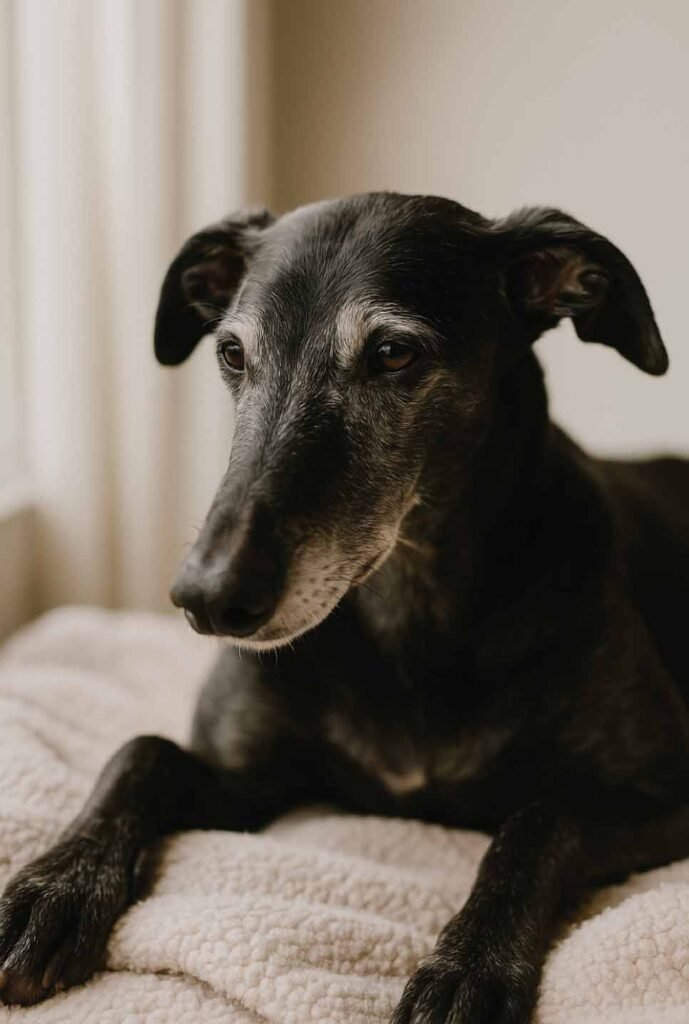
Dog Nutrition: Frequently Asked Questions (FAQs)
It depends on your dog’s age, health, and tolerance for new foods. If your dog is healthy and happy, you don’t need to switch brands often. When you do, transition gradually over 7–10 days to avoid stomach upset. A vet might recommend a change sooner if your dog develops sensitivities, weight issues, or a medical condition.
Yes! Mixing wet and dry food can add variety, hydration, and flavor, especially for picky eaters or seniors with dental issues. Just make sure the combination stays “complete and balanced” according to AAFCO standards. You may need to slightly reduce the total portion size to avoid overfeeding.
Senior dogs benefit from lower-calorie, high-quality protein diets that support muscle strength, joint comfort, and immune health. Look for foods with Omega-3 fatty acids, antioxidants, and easy-to-digest ingredients. Soft or moist textures can also make mealtime more comfortable for older pups.
Treats should never exceed 10% of your dog’s total daily calories. That might be just 2–4 small biscuits, depending on your dog’s size. For guilt-free rewards, try low-calorie snacks like carrots, peas, or small bits of boiled chicken. And remember, praise counts as a treat, too!
Not always. Most online recipes lack key nutrients like calcium, zinc, or Vitamin D. If you’d love to prepare fresh meals, work with a board-certified veterinary nutritionist to create a recipe that’s complete and safe for long-term feeding. Your love matters most, and expert guidance makes it safe.
Yes, at least once a year. Even healthy dogs benefit from nutritional check-ins, especially as they age or their activity levels change. Your vet can help fine-tune portions, suggest preventive diets for joint or dental care, and spot early signs of nutrient imbalance that you might miss.
Conclusion, Nourish Their Joy, Not Just Their Bowl
At the end of the day, feeding our dogs well isn’t about perfection, it’s about presence. Every scoop, every treat, every adjustment says, “I see you, I love you, and I care about your wellbeing.”
Good nutrition is a lifelong conversation between you and your dog, one that changes with age, activity, and time spent together. What starts as puppy fuel becomes senior comfort. What begins with kibble curiosity grows into mindful, loving care.
When we feed with intention, we’re not just filling their bowl, we’re nurturing trust, health, and joy in every stage of their beautiful lives. And that’s what makes the human–dog bond so extraordinary.
💗Because love may begin with a wag, but it lasts through every meal we share.
Continue Your Journey with PetSweetJoy
If you found this guide helpful and want more friendly, experience-based pet care advice, we’d love to have you in our community.
👉 Subscribe to our newsletter for weekly tips, heartfelt stories, and simple ways to make your pet’s life even sweeter.
And if you’re ready to go a step deeper in understanding your dog’s health and nutrition, check out our beautifully illustrated eBook:
📘 Nutrition and Health for Dogs: A Joyful Illustrated Guide
Nourish your dog from the inside out with clear, vet-inspired guidance for every life stage, from puppyhood to senior years.
Because every happy, healthy dog starts with an informed, loving human, and that’s you.


